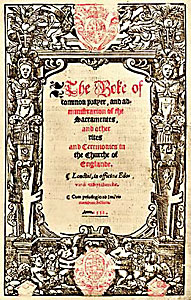In the 48 hours since the publication of the Rev'd Mark Michael's A Greener Prayerbook I have had several conversations with millennial church members, lay and ordained, about the proposals held there in. There has been much overlap in our concerns, as well as a bit of eye rolling at each other, but the general feeling is one of trepidation. What is outlined by this piece is not a representation of where we want our church, and our prayerbook, to go.
What I want to suggest is an Organic Prayerbook, one that is based more on the model of Community Supported Agriculture and less on the model of a national super market chain. The important thing moving forward into the information age is not a matter of the content of the book itself but the method of its creation and the facility to which it can be transformed to meet local needs while remaining committed to a core set of standards.
One of the core things to realize is that I am not against the concepts presented in A Greener Prayerbook from existing within our church. I recognize that in some circumstances the traditional Creeds can do more harm than good in bringing a community towards Christ. I recognize that many communities long for Eucharistic Prayers that are connected into the rhythm of the natural order and speak from that critical place of revelation to the church. I recognize that inclusive language can be a dynamic healing resource in liturgy and is crucial for some communities to reach a healthier reality around sexism. I simply do not think that any of these points are universal realities for the church that need to be put forward in the positivistic way that is inherent to making them THE PRAYERBOOK.
Notably a good part of this is that I see these concepts speaking to the generations before mine, specifically to those over the age of 50, in a way they simply do not to me and my peers. The issue is that the creation of a new BCP is a process that will take roughly two decades, a time by which 70% of current clergy will be past the retirement age. The fear is that we will spend two decades creating a BCP as our new norm that speaks principally to a generation that will be quickly worshipping God in Truth not in part with us on earth. If we create a prayerbook that we expect to be using in 2050 it needs to be principally created by those who will still be around to worship in 2050.
Which is not to say that the types of prayers and liturgical concepts that those over 50 desire should not be made manifest as worship in our church. It simply means that we do not make them into a new BCP that sets the standard for worship. There are multiple ways for us to create liturgical alternatives to the BCP that are recognized as completely valid for general use in worship as well as others allowed for use with the Bishop's discretion. The current variety of Marriage liturgies in our church is one such example, the authorized alternative prayers in the Anglican Church of Canada and the Church of England is another.
We can create a recognized inclusive language worship book, building on that already done by the Order of St. Helena, without making it the BCP. We can create an entire creation centered worship book, based perhaps on those prepared by the Iona Community, without making it the BCP. In reality by simply vetting and approving Eucharistic Prayers already in use within the Episcopal Church and the Anglican Communion we can fulfill tomorrow the needs of many of our churches in regards to worship resources. Communities that desire to use these alternative worship resources can go through a similar process as those that currently use the Anglican Missal or the 1928 BCP. We can have a system of diversity, on both ends of the spectrum, without making any change to the BCP itself and we can have it within a matter of years.
What we do need, and which Rev'd Michael points out, is a grass roots process of creating and forming liturgies that work for a parish or a region that can be offered up to the whole church. We need to make all the liturgical innovations we are doing across our church open source and create an online clearing house for all those possibilities. We need the most liked of those resources to be considered by the Standing Committee on Liturgy and Music to be made into official alternatives, like those found in Enriching our Worship. The result of this will not be a new standard BCP but a rich collection of reviewed liturgical art to which the church has access.
In doing this we are reverting to the general nature of liturgical texts and local custom that existed before the printing press and the mass standardization of the mass across each denomination and region of Europe. This is what our modern information age lends itself towards and what the Church needs to take up if it is going to be relevant for the age of electronic information. Seeking one last stand within the idiom of an information age all but gone, that of the printed book, simply is not going to help the Church. Let us move forward with clear standards for liturgical art and expectations so that we know what such must look like for general authorized use, what that must look like for alternative use under special permission, and what that looks like for communities actively engaged in liturgical experimentation... such a system will serve us so much more in the decades to come than a new Prayerbook, that however so beautiful, will be a limited cultural idiom almost as soon as it is printed.

No comments:
Post a Comment